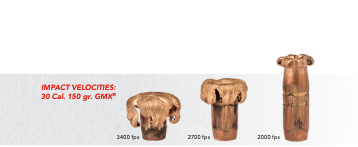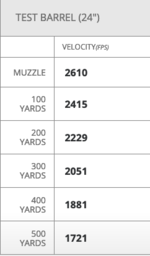I don't care about feelings when it comes to bullet performance. I care about expansion, bullet integrity, and penetration. And most of all, I care about lethality, which is what our beloved wildlife deserves. I also might have gotten sucked in by the marketing.
I shoot .308, which along with .30-06, has killed more of everything than all the other calibers put together, but I like them, too, so let's not get into it. .308 is not a rocket in terms of velocity -- we all know that -- but it works.
Last year, I killed a beautiful caribou bull with Hornady's Outfitter GMX in .308, 165 gr. Who doesn't want water-proofed primers and weather tough cartridges, right, with 95% weight retention and 1.5x expansion? But at 400 yards, those bullets went through that bull and left pencil holes. It took three shots before he fell over. That happens sometimes, and I was and am still thrilled, but I'll never use GMX again.
Look at the data I've attached from Hornady's catalog, and you'll see why. Is a .308 generally thought of as a 400-yard capable rifle? No doubt. (Do I want to shoot farther than that? No.) But look at the velocities of the Outfitter at 400 yards (1881 FPS) compared to the 2000 FPS expansion. No wonder I got pencil holes.
Call Hornady tech support and ask them what the minimum velocity is to get 50% expansion. They don't know. They'll say that the velocities for the .308 GMX bullets (150, 165, and 180) all range from 2300-3600 FPS. OK. Where did that 2300 come from, and if that's reliable, corresponding to some level of expansion on that end of the velocity spectrum, are you telling me that the .308 is only a 150 yard rifle, because that's what their own tables seem to suggest. Follow?
So, if you use GMX, make sure you're getting enough velocity to get the kind of expansion we all want, like Hornady shows us below at 2700 FPS or higher for .30 caliber, and that's going to exclude a lot of calibers at a lot of ranges with GMX bullets. For as much hype that goes into marketing 95% weight retention and 1.5x expansion, you'd think manufacturers -- for the sake of the welfare of wildlife -- would be eager to share what minimum velocities are required to actually obtain whatever percentage expansions and not make us make the inferences.


I shoot .308, which along with .30-06, has killed more of everything than all the other calibers put together, but I like them, too, so let's not get into it. .308 is not a rocket in terms of velocity -- we all know that -- but it works.
Last year, I killed a beautiful caribou bull with Hornady's Outfitter GMX in .308, 165 gr. Who doesn't want water-proofed primers and weather tough cartridges, right, with 95% weight retention and 1.5x expansion? But at 400 yards, those bullets went through that bull and left pencil holes. It took three shots before he fell over. That happens sometimes, and I was and am still thrilled, but I'll never use GMX again.
Look at the data I've attached from Hornady's catalog, and you'll see why. Is a .308 generally thought of as a 400-yard capable rifle? No doubt. (Do I want to shoot farther than that? No.) But look at the velocities of the Outfitter at 400 yards (1881 FPS) compared to the 2000 FPS expansion. No wonder I got pencil holes.
Call Hornady tech support and ask them what the minimum velocity is to get 50% expansion. They don't know. They'll say that the velocities for the .308 GMX bullets (150, 165, and 180) all range from 2300-3600 FPS. OK. Where did that 2300 come from, and if that's reliable, corresponding to some level of expansion on that end of the velocity spectrum, are you telling me that the .308 is only a 150 yard rifle, because that's what their own tables seem to suggest. Follow?
So, if you use GMX, make sure you're getting enough velocity to get the kind of expansion we all want, like Hornady shows us below at 2700 FPS or higher for .30 caliber, and that's going to exclude a lot of calibers at a lot of ranges with GMX bullets. For as much hype that goes into marketing 95% weight retention and 1.5x expansion, you'd think manufacturers -- for the sake of the welfare of wildlife -- would be eager to share what minimum velocities are required to actually obtain whatever percentage expansions and not make us make the inferences.


